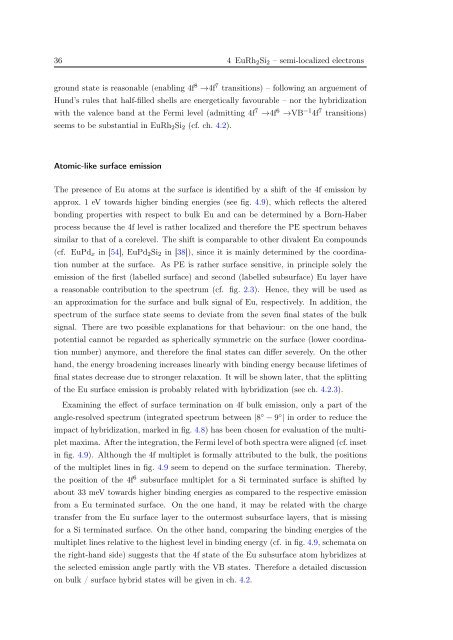Diploma - Max Planck Institute for Solid State Research
Diploma - Max Planck Institute for Solid State Research
Diploma - Max Planck Institute for Solid State Research
You also want an ePaper? Increase the reach of your titles
YUMPU automatically turns print PDFs into web optimized ePapers that Google loves.
36 4 EuRh 2 Si 2 – semi-localized electrons<br />
ground state is reasonable (enabling 4f 8 →4f 7 transitions) – following an arguement of<br />
Hund’s rules that half-filled shells are energetically favourable – nor the hybridization<br />
with the valence band at the Fermi level (admitting 4f 7 →4f 6 →VB −1 4f 7 transitions)<br />
seems to be substantial in EuRh 2 Si 2 (cf. ch. 4.2).<br />
Atomic-like surface emission<br />
The presence of Eu atoms at the surface is identified by a shift of the 4f emission by<br />
approx. 1 eV towards higher binding energies (see fig. 4.9), which reflects the altered<br />
bonding properties with respect to bulk Eu and can be determined by a Born-Haber<br />
process because the 4f level is rather localized and there<strong>for</strong>e the PE spectrum behaves<br />
similar to that of a corelevel. The shift is comparable to other divalent Eu compounds<br />
(cf. EuPd x in [54], EuPd 2 Si 2 in [38]), since it is mainly determined by the coordination<br />
number at the surface. As PE is rather surface sensitive, in principle solely the<br />
emission of the first (labelled surface) and second (labelled subsurface) Eu layer have<br />
a reasonable contribution to the spectrum (cf. fig. 2.3). Hence, they will be used as<br />
an approximation <strong>for</strong> the surface and bulk signal of Eu, respectively. In addition, the<br />
spectrum of the surface state seems to deviate from the seven final states of the bulk<br />
signal. There are two possible explanations <strong>for</strong> that behaviour: on the one hand, the<br />
potential cannot be regarded as spherically symmetric on the surface (lower coordination<br />
number) anymore, and there<strong>for</strong>e the final states can differ severely. On the other<br />
hand, the energy broadening increases linearly with binding energy because lifetimes of<br />
final states decrease due to stronger relaxation. It will be shown later, that the splitting<br />
of the Eu surface emission is probably related with hybridization (see ch. 4.2.3).<br />
Examining the effect of surface termination on 4f bulk emission, only a part of the<br />
angle-resolved spectrum (integrated spectrum between |8 ◦ − 9 ◦ | in order to reduce the<br />
impact of hybridization, marked in fig. 4.8) has been chosen <strong>for</strong> evaluation of the multiplet<br />
maxima. After the integration, the Fermi level of both spectra were aligned (cf. inset<br />
in fig. 4.9). Although the 4f multiplet is <strong>for</strong>mally attributed to the bulk, the positions<br />
of the multiplet lines in fig. 4.9 seem to depend on the surface termination. Thereby,<br />
the position of the 4f 6 subsurface multiplet <strong>for</strong> a Si terminated surface is shifted by<br />
about 33 meV towards higher binding energies as compared to the respective emission<br />
from a Eu terminated surface. On the one hand, it may be related with the charge<br />
transfer from the Eu surface layer to the outermost subsurface layers, that is missing<br />
<strong>for</strong> a Si terminated surface. On the other hand, comparing the binding energies of the<br />
multiplet lines relative to the highest level in binding energy (cf. in fig. 4.9, schemata on<br />
the right-hand side) suggests that the 4f state of the Eu subsurface atom hybridizes at<br />
the selected emission angle partly with the VB states. There<strong>for</strong>e a detailed discussion<br />
on bulk / surface hybrid states will be given in ch. 4.2.
















